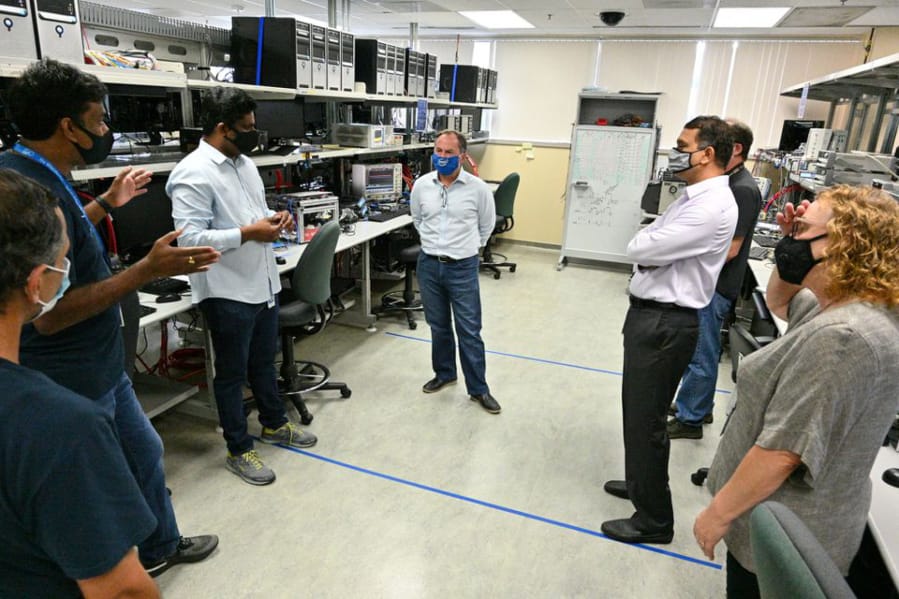Intel conceived its latest microprocessor four years ago, in a very different world.
No one envisioned a pandemic, millions of people working in their apartments, basements and attics. And Intel didn’t anticipate a succession of manufacturing problems that have cost the company its cherished edge in semiconductor technology.
So that new processor for PCs and laptops, called Tiger Lake, arrives Wednesday at a crucial moment.
It represents an enormous opportunity for Intel to capitalize on surging demand for laptops as millions of people adjust to working from home. And it’s a chance for the company to prove its technology prowess at a moment when the market has begun to doubt it.
“Tiger Lake, what it really shows, is the best transistors in the world still are Intel’s,” said Boyd Phelps, an Oregon engineering vice president who helped lead design of the new processor.
Intel crafted Tiger Lake at its Jones Farm campus in Hillsboro and the first chips are already coming off the line at the company’s Ronler Acres factory complex nearby. More than 1,000 Oregon employees worked to develop the chip since 2016, an especially big technical leap made possible by the intense collaboration among Hillsboro engineers.
“That really helped us understand how big a swing we could take with the actual design,” he said.
Key to the new chip is a redesigned transistor Intel calls “SuperFin,” which enables higher performance and better power management. The company says it’s making other improvements to the graphics processor and incorporating artificial intelligence capabilities to create a more “responsive” chip.
Many major laptop manufacturers, among them Acer, Dell, HP, Leonvo and Samsung, have signed on to use Tiger Lake on their machines. Intel says Tiger Lake laptops will be widely available by Christmas.
“Tiger Lake is the result of real solid design and manufacturing process collaboration and optimization, and it was a processor that was really born and raised in Oregon,” said Gregory Bryant, the Hillsboro executive who heads Intel’s PC group.
Tiger Lake is known formerly as the 11th generation of Intel’s brand of Core processors. Inside the company and the industry, though, Intel typically names new chips for geographic features – especially lakes. Tiger Lake is named for a lake across Puget Sound from Seattle.
Though Intel’s headquarters are in Silicon Valley, the company’s largest site is in Washington County, where the company employs 21,000. It’s Intel’s most advanced operation and it’s where the company makes each new generation of microprocessor, before replicating production at factories in Arizona, Israel and Ireland.
Sometimes, the processors are also architected in Oregon. Such was the case with Tiger Lake, with a team assembling in 2016 and 2017 to gauge what laptops would need in 2020 – and what Intel could realistically deliver.
Since that time, Intel suffered a string of delays to its 10-nanometer processor, which hit the market years late last winter. Intel disclosed in July that its forthcoming 7nm chips, originally due in 2021, are now also a year behind schedule, amid persistent manufacturing defects. The news shocked investors, who knocked more than $40 billion off of Intel’s market value.
Before the recent delays, Intel used to deliver new processors with smaller features used to arrive regularly every two years. The advances enabled more powerful chips that used less power and – because they were smaller – cost less to make.
As features on chips approach the atomic scale, though, it’s become more difficult to keep up that pace. So Intel has placed more emphasis on making its interim upgrades more powerful, and that’s where Tiger Lake fits in, adapting the current 10nm manufacturing process for a more powerful processor.
Intel says it capitalized on its new transistor design to create a faster, more responsive chip that uses power much more efficiently. The company says Tiger Lake laptops don’t slow up to conserve power when they’re not plugged into an outlet – but don’t drain the battery any faster than those that do throttle performance.
“From a competitive standpoint that is a major differentiating factor,” Phelps said.
Semiconductor technology is arcane and many of the most advanced chips end up in server farms that few people ever see. Tiger Lake, by contrast, is aimed squarely at the laptop market – office workers riding out the pandemic at home and students learning far from the classroom.
After four years of work, Phelps said he’s looking forward to getting the new laptops into consumers’ hands – and showing off the work he and his Oregon colleagues put into them.
“If nothing else,” Phelps said, “you get to tell your mom and dad.”



